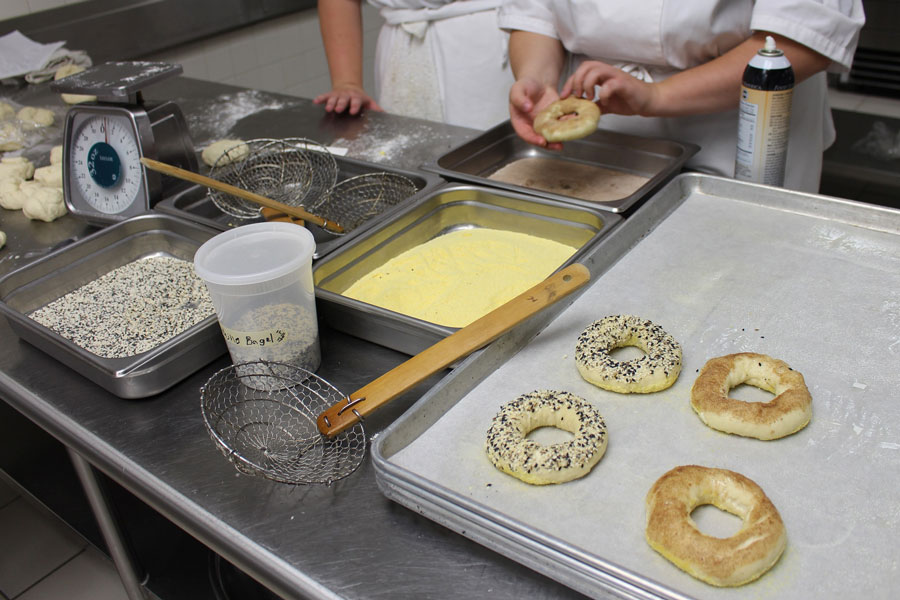Bagels are so versatile, you can slice them open and make a sandwich, eat them with flavored cream cheese or enjoy them just like they are. They can be grilled, toasted or twice baked. The various flavor combinations of bagels are endless. And best of all, bagels are easy to make. I poach my bagels in a honey solution. This sears the outside of the bagel creating a crust that is chewy.
Sponge
• 3 1/2 cups flour
• 2 1/4 cups water
• 3/4 tsp. active dry yeast
To add to the sponge:
• 1 Tbsp. kosher salt
• 1 scant Tbsp. honey
• 1 Tbsp. molasses
• 3 cups flour
• Poppy seeds, sesame seeds, coarse salt or other garnish (optional but recommended)
Poaching liquid:
• 2 cups honey
• 1 gallon water
Combine the flour, water and active dry yeast (sponge ingredients) in the bowl of a standing mixer and mix with a spoon until combined. Set aside at room temperature for 4 to 12 hours. Do this before going to bed if you want fresh bagels in the morning.
Add salt, honey, molasses, and finally the flour to the sponge. Attach dough hooks to your mixer and mix at low speed for eight to 10 minutes. This is a stiff, bulky dough, so don’t walk away from the mixer if it has a tendency to walk across your counter top. I’ve had more than one mixer hit the floor and it is distressing. (This can also be mixed by hand.)
Once the dough is mixed, remove it to your counter and cover with a cloth to let it rest for five to 10 minutes. While the dough is resting place a wide, fairly deep pot filled with water on the stove to heat and add two cups honey. Pre-heat your oven to 450 degrees.
Divide the dough into 12-13 (4 oz.) pieces. Round each piece and set aside to rest for a few more minutes, covered.
To shape take each ball of dough and flatten out slightly using the palm of the hand, making a disc approximately 3.5 inches wide. Make a hole in each using your thumb and place back on the counter, covered, to rise.
After 10 minutes, flip each bagel over so the bottom is now facing up. When this side begins to get slightly puffy and rounded. it is time to boil. This may take as little as five minutes, but depending on the temperature of your kitchen, how cold your countertop is, etc., it might take longer. When the bagel looks and feels a bit puffy, it’s ready to boil.
While your bagels are in their final rise bring your water to a simmer, then add the honey.
Drop the bagels three to four at a time into the simmering water (depending on how large your pot is). They should float immediately or within a few seconds. Let them simmer for one minute, then flip them over using a chopstick or spoon and let the other side simmer for one minute. Remove from the water using a skimmer or large spoon.
Sprinkle them with sesame, poppy seeds, salt or whatever you prefer immediately after removing them from the water, or alternately, brush with an egg wash and sprinkle after that.
Bake at 450 degrees for 12 to 13 minutes or until golden brown on a half-sheet pan lined with parchment paper or on a pizza stone.
Chef Deborah Misik is a baking and pastry arts instructor at The Culinary Institute of Montana at Flathead Valley Community College. She is a certified executive pastry chef and a certified culinary educator through the American Culinary Federation. For more information about the Culinary Institute of Montana at FVCC, visit www.culinaryinstituteofmt.com.
